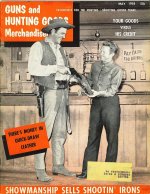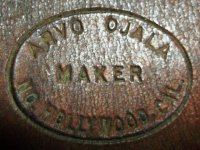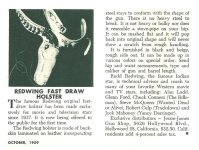rednichols
Member
- Joined
- Jul 24, 2012
- Messages
- 2,745
- Reaction score
- 8,503
. . . is inextricably entwined with Andy Anderson, whose story is somewhat less entwined with Roy Baker and Milt Sparks.
Notice I say "real" as opposed to "true" because the story has been told many times, in different ways, usually building one from another. So what's true, when even a first-person interview these legends, results in more legends of their own devising (e.g., read John Bianchi's "American Legend" book).
Anyway, Arvo's parents were from Finland (some official documents disagree about both being Finnish originally) which is worth mentioning only because his name is not Spanish, and so not pronounce "Ohala" but as "Odjalah". Mention is made in his histories of apple farming, but Arvo was an airplane mechanic in the Pacific Northwest.
The story holds that Arvo came to Hollywood in the early Fifties, bothered that the Hollywood gun handling he saw in flim and television was inadequate. And he came, to be an actor.
Instead he turned to teaching gun handling, and it was from that his holster developed. Likely he was inspired to invent his holster from seeing that of Rodd Redwing, who was a well-known instructor to Hollywood in his own right. Redwing indeed was half Indian -- East Indian, whose accent was compared in one article as being very Cary Grant (educated in England). Rodd's reinforcements were on the outside of the holster and Arvo's inside, between layers of leather.
Arvo's original holster, pictured with Marilyn Monroe, was quite crude. Arvo initially had his holster made by Ed Bohlin, and Arvo hired Andy Anderson away from Ed's shop to build his sets. Andy, too, had come to Hollywood to become an actor; he was actually a saddlemaker.
Alfonso's son, and others, have told me that Arvo never made any of his holsters himself. By the late 1950s Andy is listed as Arvo's shop manager, and Alfonso is working with him as well, having been sent to Daisy's factory to teach its factory people how to make its licensed replica of Arvo's set.
First Arvo and Bohlin had a big falling out, resulting in Arvo winning a lawsuit for unfair competition against Ed. A source tells me that Ed never recovered interest in his business after that (early 1960s). By then Andy and Arvo had a big falling out, but in this case it was Arvo who lost the suit, and in a big way -- he was legally barred from doing business in California for five years. Arvo shifted back up to Washington state and, by the time he returned to CA in the late 1960s, Andy owned the market.
Andy, though, was doomed to troubles of his own. The Sylmar quake in the early '70s destroyed his shop, he had several major strokes, and then he, too was out of business 1975. During this latter period, Milt Sparks had slipped in with his copies of Andy's products and Andy was literally powerless to stop him.
Roy Baker had a big hit with his pancake invention at just about that time; and Roy had apprenticed with Andy in the late 1950s as a saddle maker. I'm told they remained friends for life, including that they shared hardware bulk buys and Andy allowed Roy to make his trademark mag pouch. Andy, in 1980, entered into a licensing agreement with Cobra, a spinoff from JayPee by the son. Both Andy and Roy lived and died an almost identical lifespan: 1920 to 1990. Arvo literally had the last laugh, living until 2005.
Notice I say "real" as opposed to "true" because the story has been told many times, in different ways, usually building one from another. So what's true, when even a first-person interview these legends, results in more legends of their own devising (e.g., read John Bianchi's "American Legend" book).
Anyway, Arvo's parents were from Finland (some official documents disagree about both being Finnish originally) which is worth mentioning only because his name is not Spanish, and so not pronounce "Ohala" but as "Odjalah". Mention is made in his histories of apple farming, but Arvo was an airplane mechanic in the Pacific Northwest.
The story holds that Arvo came to Hollywood in the early Fifties, bothered that the Hollywood gun handling he saw in flim and television was inadequate. And he came, to be an actor.
Instead he turned to teaching gun handling, and it was from that his holster developed. Likely he was inspired to invent his holster from seeing that of Rodd Redwing, who was a well-known instructor to Hollywood in his own right. Redwing indeed was half Indian -- East Indian, whose accent was compared in one article as being very Cary Grant (educated in England). Rodd's reinforcements were on the outside of the holster and Arvo's inside, between layers of leather.
Arvo's original holster, pictured with Marilyn Monroe, was quite crude. Arvo initially had his holster made by Ed Bohlin, and Arvo hired Andy Anderson away from Ed's shop to build his sets. Andy, too, had come to Hollywood to become an actor; he was actually a saddlemaker.
Alfonso's son, and others, have told me that Arvo never made any of his holsters himself. By the late 1950s Andy is listed as Arvo's shop manager, and Alfonso is working with him as well, having been sent to Daisy's factory to teach its factory people how to make its licensed replica of Arvo's set.
First Arvo and Bohlin had a big falling out, resulting in Arvo winning a lawsuit for unfair competition against Ed. A source tells me that Ed never recovered interest in his business after that (early 1960s). By then Andy and Arvo had a big falling out, but in this case it was Arvo who lost the suit, and in a big way -- he was legally barred from doing business in California for five years. Arvo shifted back up to Washington state and, by the time he returned to CA in the late 1960s, Andy owned the market.
Andy, though, was doomed to troubles of his own. The Sylmar quake in the early '70s destroyed his shop, he had several major strokes, and then he, too was out of business 1975. During this latter period, Milt Sparks had slipped in with his copies of Andy's products and Andy was literally powerless to stop him.
Roy Baker had a big hit with his pancake invention at just about that time; and Roy had apprenticed with Andy in the late 1950s as a saddle maker. I'm told they remained friends for life, including that they shared hardware bulk buys and Andy allowed Roy to make his trademark mag pouch. Andy, in 1980, entered into a licensing agreement with Cobra, a spinoff from JayPee by the son. Both Andy and Roy lived and died an almost identical lifespan: 1920 to 1990. Arvo literally had the last laugh, living until 2005.
Last edited:









